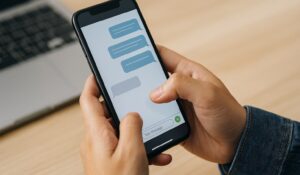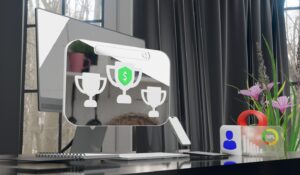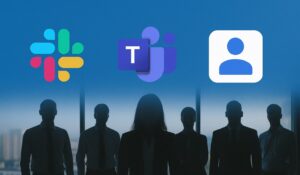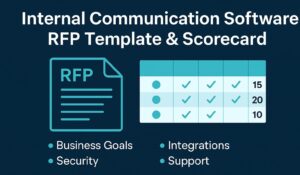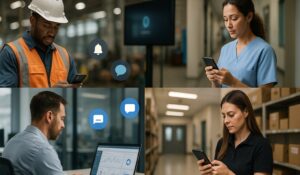Workplace communication has evolved dramatically over the last few years. With team communication apps for hybrid work becoming the backbone of modern offices and the best apps for deskless workers shaping frontline engagement, organizations are under pressure to rethink how they connect, inform, and engage their teams. According to a McKinsey report, nearly six in ten employees have the option to work remotely at least part of the week, while Gallup research shows that 80% of the workforce is deskless — highlighting the scale of the challenge.
Employees today expect instant access to information and seamless digital experiences — whether they are working from home, at a desk in the office, or on the frontline of a manufacturing plant. For HR managers, IT teams, and operations leaders, the challenge is no longer just sending out information. It’s about making sure the right people get the right message at the right time, across multiple devices and channels. That’s where specialized tools like team communication software and internal communication tools come in. In this article, we’ll explore the current state of hybrid and deskless communication, highlight the must-have features of effective tools, and compare the best platforms — including why HubEngage stands out with its multi-channel approach and gamification capabilities.
The Hybrid & Deskless Communication Challenge
The way we work has permanently shifted. According to a McKinsey study, 58% of employees say they have the option to work from home at least one day a week, while Gallup reports that 80% of the global workforce is now “deskless” — working in manufacturing, healthcare, retail, construction, transportation, and hospitality.
That means today’s HR, IT, and operations leaders face a dual challenge:
- Hybrid teams need tools that bridge office, home, and remote environments.
- Deskless teams need mobile-first access, often in locations with limited connectivity.
Traditional intranets and email chains fall short. The new standard is team communication apps for hybrid work and deskless employee comms tools designed to be mobile-first, secure, and multi-channel. This means the communication challenge is larger than ever before. Hybrid and deskless workforces require solutions that go beyond email or static intranets, offering mobile-first communication tools and multi-channel delivery to ensure every employee is included.
Hybrid Workplaces in 2025
Post-Covid, hybrid work has matured into a default expectation. Employees no longer see remote options as perks — they are requirements. A 2024 McKinsey survey found that 87% of employees who can work remotely choose to do so at least part-time. At the same time, organizations are facing challenges around culture, productivity, and connection.
- Office attendance remains below 60% of pre-pandemic levels (Bloomberg).
- Hybrid workplaces are adopting “intentional presence policies” — mandating in-office days tied to collaboration, not clocking time.
- Leaders are investing more in digital-first employee experience platforms to ensure distributed workers feel connected and informed.
The future of hybrid work isn’t about where employees sit — it’s about how well they stay connected through seamless digital communication.
Must-Have Features for Hybrid & Deskless Communication Apps
When evaluating mobile-first communication tools, HR and IT leaders should prioritize features that support inclusivity and real-time delivery:
- Offline access: Deskless workers in the field may not have consistent Wi-Fi. Apps must allow offline reading and push updates once reconnected.
- Automatic translation: Hybrid and global workforces need instant translation for multi-language inclusivity.
- Mobile-first UX: For warehouse staff, nurses, or field engineers, the phone is the primary interface. The design must prioritize quick taps, not desktop dashboards.
- Multi-channel reach: The ability to deliver messages via push notifications, SMS, WhatsApp, Teams, Slack, and email ensures no employee misses critical updates.
- Digital signage: For industries like manufacturing, screens on shop floors remain a powerful way to connect workers who don’t carry devices.
Best Hybrid Team Communication Apps
Examples
Some of the best apps for hybrid communication include:
- Microsoft Teams – Strong for knowledge workers, video meetings, and file sharing.
- Slack – Excellent for chat, integrations, and async work across hybrid teams.
- Zoom Team Chat – Expands beyond meetings with persistent chat channels.
- HubEngage – Provides a seamless web and mobile experience with integrations into Teams, Slack, and email. This not only saves comms teams valuable time but also ensures employees receive updates on the platforms they use most.
Comparison Table – Hybrid Team Communication Apps
| Platform | Best For | Key Features | Limitations |
|---|---|---|---|
| Microsoft Teams | Knowledge workers, meetings | Video, chat, file sharing, Office 365 integration | Limited deskless reach |
| Slack | Async hybrid collaboration | Channels, integrations, workflows | Cost scales quickly with adoption |
| Zoom Team Chat | Meeting-heavy hybrid teams | Video + chat, persistent channels | Weak outside video-first use cases |
| HubEngage | Hybrid + deskless inclusivity | Multi-channel reach, Teams/Slack/Email integration, mobile-first UX | Built for comms, not deep project mgmt |
Best Apps for Deskless Workers
For frontline staff, the needs are different. Deskless employees want quick, actionable updates, not endless channels. The best apps for deskless workers emphasize:
- Ease of use: No training needed.
- Alerts & confirmations: Read receipts and acknowledgments for compliance.
- Role-based messaging: Store managers get operational updates; nurses get shift alerts; technicians get safety reminders.
- Integration with scheduling, payroll, and training systems.
Comparison Table – Deskless Worker Communication Apps
| Platform | Best For | Key Features | Limitations |
|---|---|---|---|
| Beekeeper | Hospitality & retail | Mobile-first chat, task lists, offline support | Less robust for hybrid employees |
| Blink | Transportation & logistics | Shift updates, mobile alerts, compliance workflows | Fewer multi-channel options |
| Workvivo | Deskless + social sharing | Familiar social UX, group chat, video, mobile | Privacy & adoption challenges |
| HubEngage | Manufacturing, healthcare, hybrid + deskless | Multi-channel delivery (SMS, push, WhatsApp, Teams, Slack, signage), gamification, AI chatbot | Broader comms focus vs. narrow ops |
This is where HubEngage stands apart. Unlike point solutions, HubEngage offers multi-channel communication for hybrid AND deskless teams in one platform. With push notifications, SMS, WhatsApp, Teams, Slack, email, and digital signage — it ensures everyone, from corporate staff to manufacturing floor teams, stays aligned. For industries like manufacturing, healthcare, and hospitality, HubEngage eliminates silos by unifying channels under a single, mobile-first platform.
Why Communication & Engagement Matter for Deskless Workers
Deskless workers — who make up the majority of the global workforce — are often the least engaged. According to Gallup, only 23% of employees worldwide are engaged at work, and disengaged employees cost the global economy $8.8 trillion in lost productivity annually.
- Communication gaps lead to safety issues, turnover, and poor customer service.
- Recognition and feedback loops improve satisfaction and retention.
- Engagement tools with gamification, like HubEngage, boost participation by rewarding knowledge checks, surveys, and peer recognition.
By connecting deskless employees with real-time updates, recognition programs, and interactive surveys, organizations reduce turnover, improve safety compliance, and create a culture of inclusivity.
How AI Chatbots Are Changing Communication
AI-powered assistants are transforming how employees access information. Instead of searching manuals or waiting for HR replies, workers can now ask an AI chatbot about:
- HR policies and benefits.
- Safety procedures and compliance steps.
- Training modules and onboarding.
- Shift schedules or time-off requests.
For deskless workers, this means having a 24/7 pocket advisor. For HR and IT, it means fewer repetitive questions and more time for strategy. Platforms like HubEngage embed AI-driven chatbots directly into the employee app, ensuring seamless access to critical information — personalized by role, department, and location.
Measuring Engagement & Adoption
Rolling out a new app is only half the job. HR and IT leaders need to track:
- Engagement rates: % of employees opening messages.
- Channel effectiveness: Which medium (SMS, push, signage) drives the most reach?
- Feedback loops: Pulse surveys and polls built into the app.
- Adoption trends: Are deskless teams logging in daily? Are managers pushing updates consistently?
With HubEngage, engagement is built-in: gamification, AI-driven content recommendations, and real-time analytics help teams not just measure adoption, but actively increase participation.
Final Takeaway
Hybrid and deskless communication is no longer a “nice-to-have” — it’s a strategic necessity. With 58% of employees working hybrid and 80% deskless globally, the winners will be organizations that provide team communication apps for hybrid work alongside the best apps for deskless workers in a unified, multi-channel experience.
Team communication apps and internal communication tools prove that the future isn’t about single apps — it’s about unified systems. And that’s why HubEngage is built for the workforce of today: one app, all channels, every employee.
👉 Ready to see how it works? Book a demo of HubEngage today and discover how you can connect every employee in minutes.
FAQs
What is the best communication app for hybrid teams?
The best apps for hybrid teams balance chat, video, and integrations. Microsoft Teams and Slack are widely used, but for organizations that need multi-channel reach (push, SMS, signage), HubEngage provides a more inclusive solution for both knowledge and deskless workers.
How do you communicate with deskless workers?
Deskless workers should be reached via mobile-first communication tools that include SMS, push notifications, WhatsApp, and digital signage. The key is using multi-channel delivery so messages reach employees wherever they are, regardless of device or connectivity.
Which apps work offline for field employees?
Platforms like HubEngage and Beekeeper allow offline reading of messages, syncing once the employee reconnects. Offline access ensures critical safety or operations updates are not missed in low-connectivity environments.



